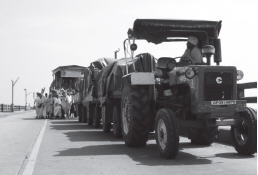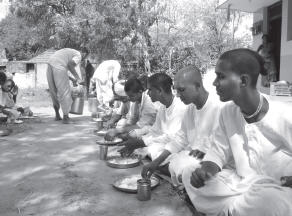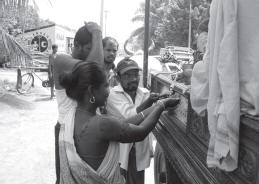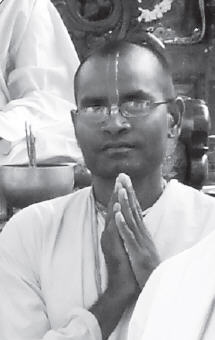The world’s longest running pilgrimage on
foot is celebrating its 25th anniversary.
Here is a report on its activities.
25 years, 1,15,000 km on foot, and six circles of India later, Padayatra India is celebrating its silver jubilee on Radhastami 2009. With a temple on cart pulled by bulls, a tractor with three attached wagons, and a crew of twenty plus devotees on foot, the padayatra is a moving carnival that travels all over India displaying Krishna consciousness in areas you have never seen, been there, or heard about. Inspired by Srila Prabhupada and implemented by his disciple His Holiness Lokanatha Swami, Padayatra India is the longest running project of its kind, and a motivation for nearly hundred such padayatras all over the world from a couple-with-kids’ travel in a horse-driven cart in USA, to solitary monk’s walk across Canada. Efficiently organized and robustly equipped, the padayatra attracts all varieties of members, from veteran Srila Prabhupada’s disciples, to the latest entrants in Krishna consciousness.
They must be having a lot of fun, I thought, as I found them in March 2009 in Belgaum, Karnataka, celebrating the Gaura Purnima festival and also undertaking much-needed renovation of their equipments. Their leader Rupa Goswami Dasa readily agreed for an interview, and the next morning after heaving boxes of Srila Prabhupada’s books in to the wagon, he washed his hands and took me to his quarters where we had a pleasant discussion sitting on floor mats.
BTG: Since how long have you been associated with padayatra?
Rupa Goswami Dasa (RGD): Over eight years. Before joining padayatra, I worked as a company secretary in Delhi for some time.
BTG: Please tell us about your daily routine.
RGD: We follow the temple schedule, but with some alterations. Mangala-arati is at 4:30 am. Then we chant japa for two hours and after darshana at 7:30, the devotees and the ratha carring Gaura-Nitai Deities and Srila Prabhupada move. The cooks stay behind to prepare breakfast and once it is ready they load everything into the wagons, and leave with the tractor catching up with the devotees by 9 am. We halt after a walk of about 6-7 km and have breakfast near some source of water. Again, the tractor, cooks, and the pujari leave for a pre-arranged destination, and cooking for lunch begins.
The cart and devotees catch up with them at 1-2 pm after a walk of 12-15 km. Juice or buttermilk greets the weary and thirsty travelers. Some bathe, some read, and others stretch out. Hot lunch of rice, dal, two vegetables, chapati, and sweet is served at 4:30. While honoring prasada we hear lectures, followed by a class at 5:30pm. An hour later we do harinama in the village where we pass out pamphlets and invite people for the evening program. At 7 pm there is arati and a program for villagers. When we are in a city with some devotees, they arrange evening programs for us.
The evening program has a talk of 40 minutes, a CD show on Hare Krishna world or cow protection. After lecture we serve prasada of khichari and halava, and go to bed by 9 pm. The next day we move on. In the cities, where we stay for 2-3 days, we conduct talks and programs in schools and colleges.
BTG: Where do you spend the night?
RDG: We stay in schools, temples, or community halls. In the village the village chief generally arranges for the residence and contributes grains, milk, and ghee for us and fodder for the bulls.
BTG: How do you manage the finances?

RDG: The padayatra runs on book distribution and donation of well-wishers. If we have twenty devotees we can manage our expenses by book distribution.
BTG: How do people respond to the padayatra?
RDG: They are shocked! The padayatra procession stops you dead in your tracks. First our bulls. Massively built with strikingly big horns, they invariably force you to take a second look. The ornately carved wooden altar with brilliant Gaura-Nitai Deities and life-size murti of Srila Prabhupada, surrounded by dozen or so devotees chanting and dancing, followed by a tractor pulling three trolleys appearing like a train nobody has ever seen anything like this.
We go to villages who have never heard about Krishna consciousness. Students and villagers join us for a walks and programs. There are different cultures in India, but we see that even if majority of them are poor, they still have the culture and faith to come, take darshana of the Lordships, and accept caranamrta. But now gradually the village culture is going down.
An Accident in the Rains
BTG: Can you please tell us some of your memorable experiences during padayatra?
RDG: Of course. Once we reached a village in Satana near Citrakuta, found a well and went to fetch water. Immediately all the women gathered there, began shouting and would not allow us near the well. When we ignored them and went ahead they threw their pots down, pouring out all the water in protest. The cause of their protest: For centuries the upper cast people had suppressed the lower castes not allowing them water from their wells. Now the lower castes were in majority and it was their turn to persecute the upper caste. Seeing our saffron robes, the women perceived us as upper caste brahmanas and dissented. Fortunately a brahmana arrived at the scene and he took us some distance away to a well in his farm.
Later in the evening program most of the villagers came for darshana and we distributed prasada to all without any discrimination, and every one accepted it. Next day, all those people who had objected to our presence the previous day, came to us with plates full of offerings fruits, grains, vegetables etc., and apologized for their misconduct. One night of Krishna consciousness changed lifelong enmity!
Another time in Pratapgarh, UP, I was part of the advance party. I arranged a place for the coming day and was returning to the base camp, when it began to pour. It was 8:30 pm, dark with no street lights. A heavy wind blew against my moped. So many trucks were rushing from the opposite sides and their headlights were creating myriad patterns on my wet glasses almost blinding me. Then a truck seemed to loom straight at me and I lost control. The moped skidded from the road into a ditch about 50 feet deep. I fell away from the plunging moped, grasped a bush and held on. Badly bruised and drenching wet I pulled myself up on the road. I tried to search for the moped, but I could not even make out my hand before my face in the pitch darkness. I gave up.
I waved to the passing vehicles but nobody stopped. It was almost 10:30 pm. Our place was 8-9 km away; on foot it would take about two hours. I became desperate. I remembered how it was so nice in my office, where I worked earlier as a company secretary. It was difficult at times, but not as difficult as now! (Smiles) I was new in padayatra then. I prayed helplessly to Nitai-Gaurachandra, the presiding Deities of padayatra. “Please, Nitai-Gaurachandra, help me.”
Two or three trucks later a jeep arrived. I was so anxious that I jumped right in the middle of the road and frenetically waved my arms. The jeep screeched to a halt. The passengers peeked from the windows, “We know you,” they said. “We saw your ratha in the school today.” The jeep was going to the same village as I. I mentioned my moped. No one will come in the jungle to pick it up, they told me. Muddy, bruised, and with bleeding knees and elbows, I sat in the vehicle and reached the devotees at 11:30 pm. Every one was awake, worried; there were no cell-phones those days. After some much-needed first-aid, I went to bed.
The next day I reached the spot of the accident. The moped lay in sticky mud. After a wash we tested it it was fine!
I realized that when we pray, Lord Krishna protects. But we should not wait for calamity to pray. We are always in danger; therefore we should not wait for a real calamity to fall upon us to pray. Pray always.
Here, Kerala is the best place for book distribution. The state with the highest literacy rate also seems to have the most interested readers, with many Christian and Muslims also buying books. In two months we sold 6,300 books.

I thank Rupa Goswami Dasa and leave, later meeting Holland-born Akhiladhara Dasa, a disciple of Srila Prabhupada. A padayatra veteran, he was a former member of Padayatra America and Padayatra India, and now has been traveling with Padayatra India for the past few months. His talk appears in the side bar.
I then spoke to Mohana Rupa Dasa, a padayatri for nine years. How he came to Krishna consciousness is a interesting story. (See “A Hunting Excursion”, page 17.) He narrated his experience:
“One day I was driving the tractor and took a turn from the end of a big bridge to a steep road below. The advance party devotees and the ratha had successfully negotiated the turn and were going ahead. A devotee sitting beside me advised, ‘It is a slope, so switch to neutral gear and let the tractor roll gradually. Brake intermittently to control.’ ‘Do you think I am a fool?’ I answered back, ‘I know how to drive.’ I shifted to the first gear, hoping that it was sufficient to slow down the massive tractor.
“A couple of moments later the tractor toppled over, due to the sheer weight of the trolleys. I was still on the seat with the steering wheel in my hands; the only difference was that the wheels rolled over my head. Somehow my entire body was shielded by the inverted seat. I experienced as if I was no more inside my body. Then I felt the impact of one trolley toppling over the tractor. I was convinced that I was going to be crushed. But nothing happened. Then the second and third trolleys toppled over; I was still breathing.
“The impact shook me to consciousness. I tried to switch off the tractor, and then somehow crawled my way outside. People were shocked to see me alive. A group of fifty villagers arrived with two tractors for help and towed our trolleys and the tractor.
“Many of the villagers went to the bridge, stopping the passing vehicles, pointing to them our plight, and begging money for us. Our kitchen was damaged; we only had some puffed rice and halva, which we distributed to them.
“Perhaps we have to pay them for towing out our tractor, I thought. In the evening, however, the mukhiya (village chief) came to me and handed me Rs. 7,000/, their collection. They did not want anything.
“Meanwhile the ratha returned to the spot of causality. There were three devotees beside me on the tractor, and baring one, everyone escaped without any injury. Throughout this major accident the Lord sheltered me like the way one securely packs fruits for export. My heart went out to Him. I came before Nitai-Gaurasundar. ‘Why did You save me?’ I asked Them, realising that if we serve Lord Krishna, even if little bit, the Lord saves us from the greatest danger. Nehabhikrama-naso ‘sti. . . I also learnt that whenever we get good advice whether from a senior or junior we should listen.
The Merciful Lord
I also met Vajrangi Dasa, who joined padayatra in 2002 in Dvaraka. He says:
“Once in a village in Tamil Nadu we were performing the evening arati with about 70-80 people. Suddenly around 25 people, who were completely drunk, arrived on the scene and began pushing, pulling, and shoving others while dancing, disturbing us so much that we finally stopped the program and distributed prasada.

“The next day during darshana, these men arrived again. We braced ourselves for more problems.
“ ‘Please stay for one more day,’ they were repenting. ‘Please forgive us for our acts last night. We could not get proper guidance from you because of our inebriated state.’
“Our program was fixed so we could not stop, but they were so apologetic that they walked with us for the next ten km.
“I was wondering how much mercy they must have got by dancing before Gaura-Nitai. I was reminded of the words of Srila Locana Dasa Thakura. Adhama patita jiver dvare dvare giya hari-nama maha-mantra deno bilaiya: ‘Going from door to door in the residences of the most fallen and wretched souls, Lord Nityananda freely distributes the gift of the harinama maha-mantra.’
“We see in padayatra how the Lord is so merciful. This is what gives us all the bliss.”
The next day, the padayatra was ready to leave to the next destination. After the devotees loaded their belongings on the trolleys they gathered around Nitai-Gaurasundara doing blissful kirtana, and the bulls were yolked to the cart. Soon amongst waving hands and parting embraces the cart moved and the devotees walked away…to a new destination. I recalled the words of Vajrangi Dasa, “We see in padayatra how the Lord is so merciful. This is what gives us all the bliss.” Perhaps this is the spirit that keeps the padayatra rolling.
(Murari Gupta Dasa)
To know more about the padayatra, call its leader Rupa Goswami Dasa at 9444546075

